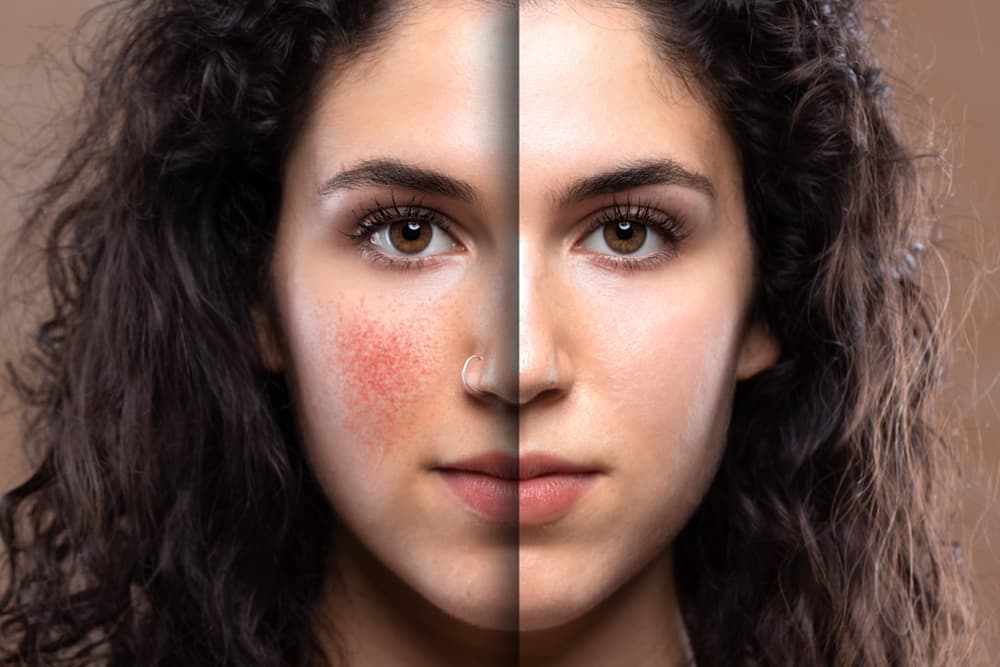Rosacea is a prevalent, chronic skin condition that affects millions of people around the globe. This inflammatory disorder typically appears on the face and can cause redness, visible blood vessels, and even acne-like breakouts. While the exact cause of rosacea remains unclear, various treatment options are available to help manage its symptoms. In this comprehensive guide, we delve into the symptoms, causes, and effective treatments for rosacea, providing insights and practical advice for those affected by this complex skin condition.
Symptoms of Rosacea
Rosacea affects individuals differently, but several common signs and symptoms are associated with the condition. These include:
Facial redness: Persistent redness, particularly in the central part of the face, is one of the most common symptoms of rosacea. This redness typically affects the cheeks, nose, chin, and forehead, and may resemble a blush or sunburn that does not go away.
Swollen, red bumps: Some individuals with rosacea may develop small, raised bumps that resemble acne. These bumps can be tender, inflamed, and sometimes contain pus. The bumps may become painful and spread across the face in more severe cases.
Visible blood vessels: As rosacea progresses, the appearance of small blood vessels on the face can become more visible. This is known as telangiectasia and can contribute to the overall redness of the skin.
Eye irritation: Rosacea can also affect the eyes, a condition called ocular rosacea. Symptoms include redness, dryness, itching, and a gritty sensation in the eyes. In some cases, the eyelids may become swollen, and styes may develop. If left untreated, ocular rosacea can potentially lead to more severe eye complications, including vision loss.
Thickened skin: In rare cases, rosacea can cause the skin to thicken, particularly around the nose. This condition, called rhinophyma, results in a bulbous, enlarged appearance of the nose and is more common in men than women.
Flushing and blushing: Many individuals with rosacea experience episodes of flushing, where the skin suddenly becomes red and warm. Factors such as emotional stress, heat, or certain foods and beverages can trigger this flushing.
Causes of Rosacea
The exact cause of rosacea is unknown, but several factors are believed to contribute to its development. Some possible factors include:
Genetics: A family history of rosacea may increase the likelihood of developing the condition. Research has shown that individuals of Northern European descent and those with a family history of rosacea have a higher risk of developing the condition.
Blood vessel abnormalities: Some researchers believe abnormalities in facial blood vessels may contribute to the redness and flushing associated with rosacea. These abnormalities may cause the blood vessels to dilate more easily, leading to increased blood flow and redness in the face.
Immune system response: An overactive immune system or an abnormal inflammatory response may play a role in the development of rosacea. Some studies suggest that people with rosacea have higher levels of certain inflammatory proteins in their skin, which could contribute to the redness, swelling, and other symptoms associated with the condition.
Environmental triggers: Sun exposure, wind, and temperature extremes can exacerbate rosacea symptoms. Other triggers may include alcohol, spicy foods, hot beverages, and exercise. Each person's triggers may vary, making it essential to identify and avoid them whenever possible.
Demodex mites: A microscopic mite called Demodex folliculorum lives on human skin and is generally harmless. However, some studies have found that people with rosacea tend to have higher numbers of these mites on their skin. It is unclear whether the mites contribute directly to rosacea or if their increased presence is a result of the skin condition.
H. pylori bacteria: Some research has suggested a link between the presence of Helicobacter pylori bacteria, commonly associated with stomach ulcers, and rosacea. The bacteria may play a role in increasing the production of a protein called gastrin, which can cause blood vessels to dilate and contribute to rosacea symptoms.
Effective Treatments for Rosacea
There is no cure for rosacea, but several treatment options are available to help manage its symptoms. These treatments include:
Topical medications: Prescription creams and gels containing antibiotics, anti-inflammatories, or retinoids can help reduce redness and inflammation. Examples of these medications include metronidazole, azelaic acid, and ivermectin. Topical retinoids, such as tretinoin, may also be prescribed to help unclog pores and improve the skin's overall texture.
Oral antibiotics: For more severe cases, oral antibiotics may be prescribed to help control inflammation and prevent flare-ups. Tetracycline, doxycycline, and minocycline are common antibiotics used to treat rosacea. These medications are typically prescribed for their anti-inflammatory properties rather than their antibacterial effects.
Laser and light therapies: Intense pulsed light (IPL) and laser treatments, such as vascular lasers or pulsed dye lasers, can help reduce redness and visible blood vessels. These treatments target the blood vessels in the skin, causing them to collapse and eventually be reabsorbed by the body. Multiple sessions may be required for optimal results, and the treatments can be expensive.
Skincare routine: A gentle skincare routine, including mild cleansers, fragrance-free products, and sun protection, can help minimize rosacea symptoms. Avoid using harsh exfoliants or products that contain alcohol, as these can exacerbate symptoms. Look for products specifically designed for sensitive skin or those labeled as suitable for rosacea-prone skin.
Lifestyle modifications: Identifying and avoiding personal triggers, such as certain foods, beverages, and stress, can help prevent flare-ups and keep rosacea under control. Maintaining a diary to track symptoms and potential triggers can be a helpful tool in managing the condition.
Medical procedures: In some cases, medical procedures may be recommended to treat more severe rosacea symptoms or complications. For example, dermabrasion or microdermabrasion can help improve the appearance of thickened skin, while surgical procedures may be necessary to treat severe cases of rhinophyma.
Alternative therapies: Some individuals with rosacea have found relief through alternative therapies, such as acupuncture, herbal remedies, or supplements. While there is limited scientific evidence to support the effectiveness of these treatments, they may be worth considering for those who have not found success with conventional therapies.
Conclusion
Rosacea is a complex and often misunderstood skin condition that can cause significant discomfort and self-consciousness for those affected. By understanding its symptoms, causes, and available treatments, individuals with rosacea can work with their healthcare providers to develop a personalized management plan that helps them lead a more comfortable and confident life. Managing rosacea requires a multifaceted approach that combines medical treatment, skincare adjustments, and lifestyle modifications. With patience, persistence, and the right support, individuals with rosacea can successfully manage their symptoms and improve their quality of life.


